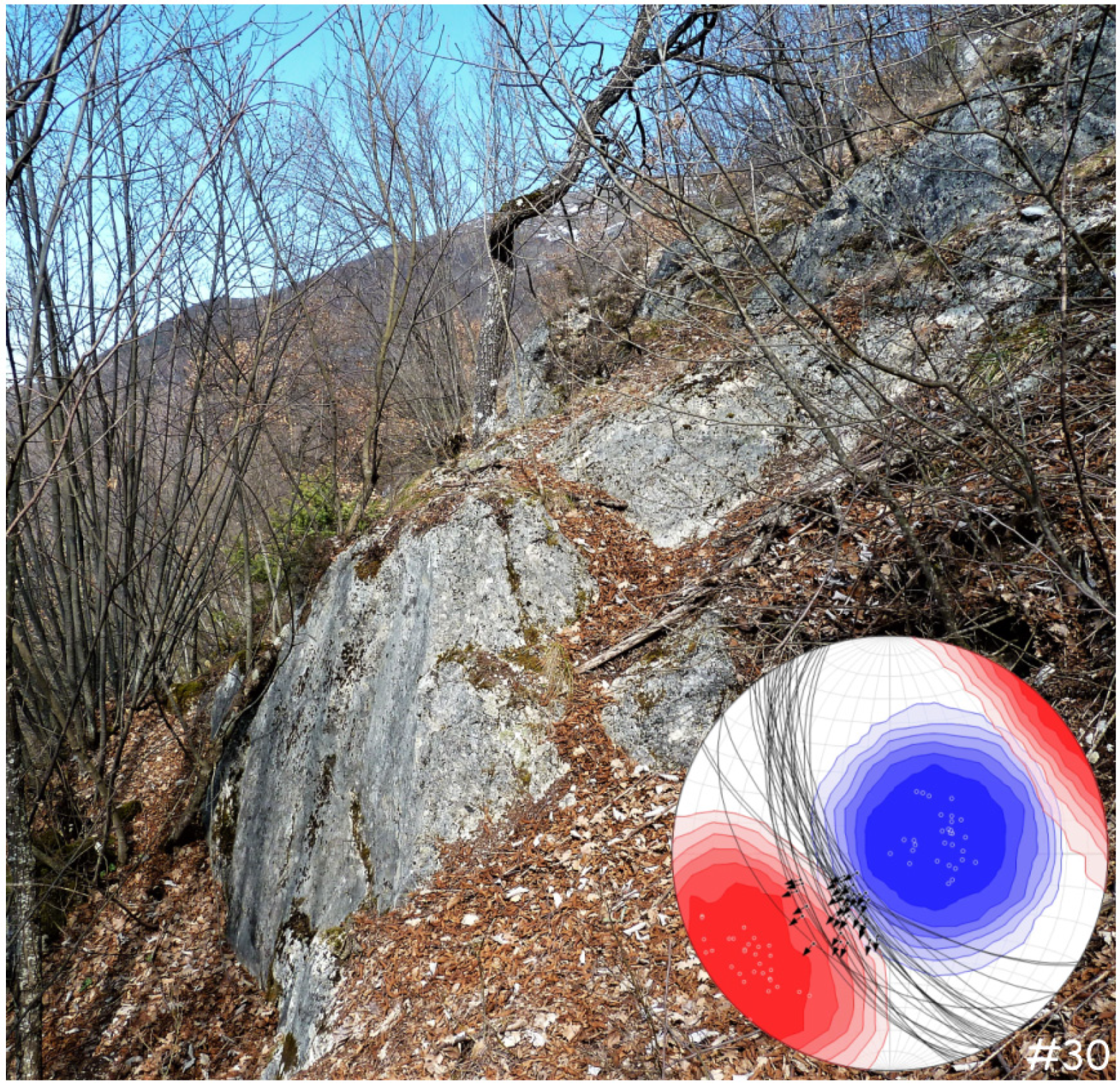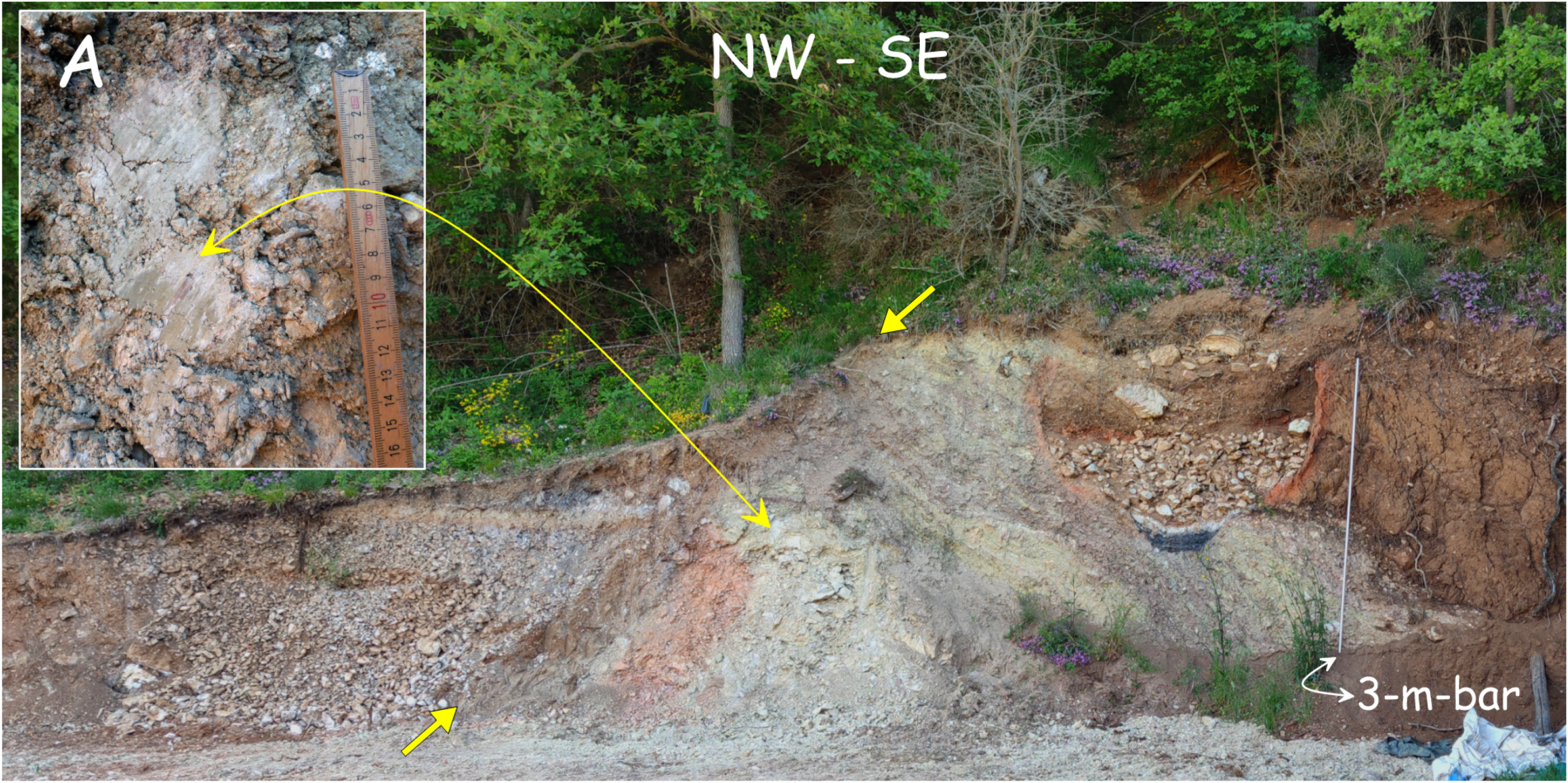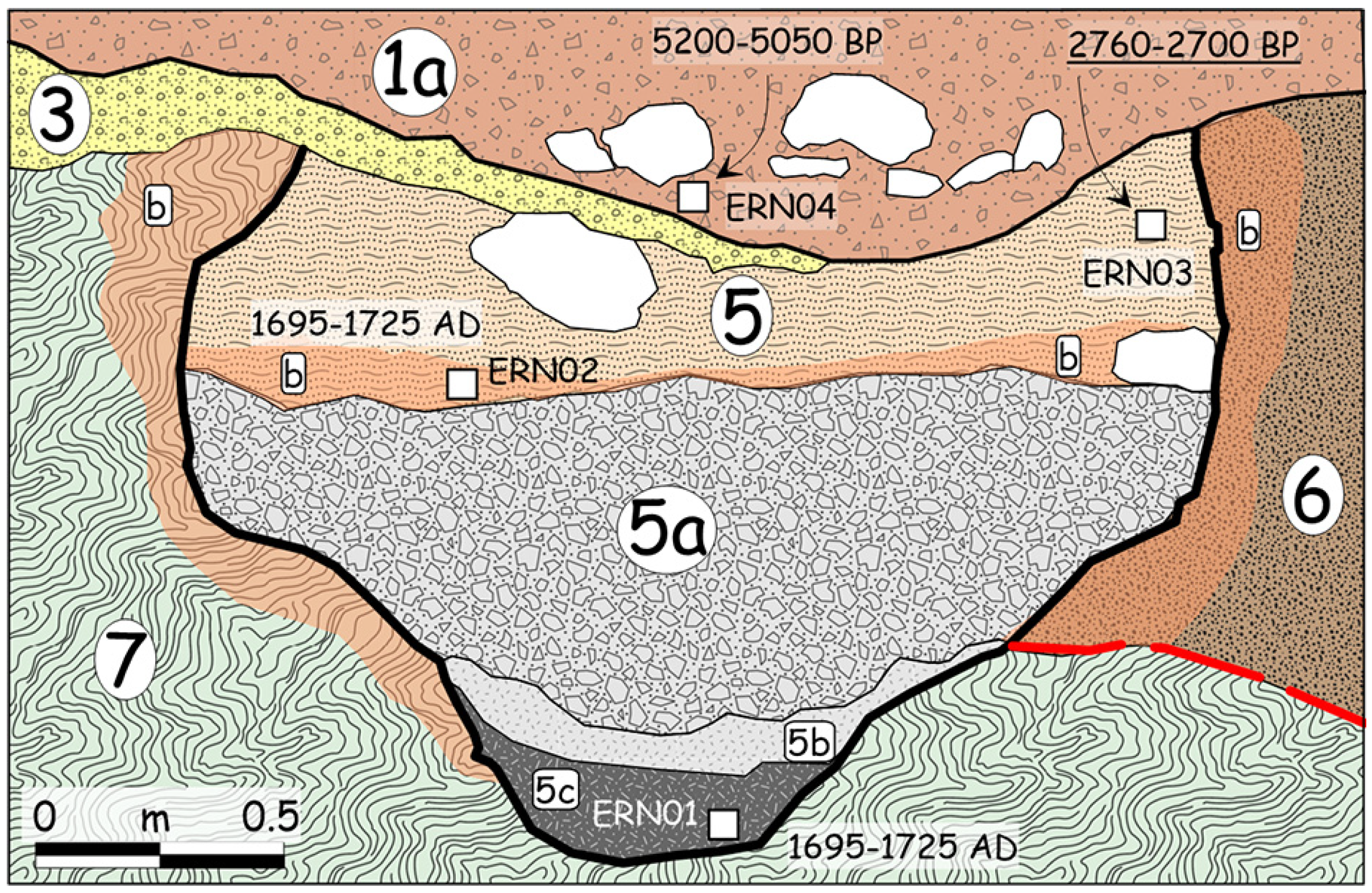Archaeoseismic Evidence of Surface Faulting in 1703 Norcia Earthquake (Central Italian Apennines, Mw 6.9)
Abstract
:1. Introduction

2. Seismotectonic Framework
2.1. Active Tectonics
2.2. Historical Seismicity
3. The Faulted Limekiln
3.1. Site Stratigraphy
3.2. Tectonics
4. Discussion
5. Conclusions
Supplementary Materials
Author Contributions
Funding
Acknowledgments
Conflicts of Interest
References
- De Rossi, M.S. La basilica di Santa Petronilla presso Roma, testé discoperta, caduta per terremoto. Bull. Vulc. Ital. 1874, 1, 62–65. [Google Scholar]
- Ghislanzoni, E. Notizie Archeologiche Sulla Cirenaica; Bertero: Roma, Italy, 1915; pp. 65–240. [Google Scholar]
- Lanciani, R. Segni di terremoti negli edifizi di Roma antica. Bull. Comm. Archeol. Comun. Roma 1918, 45, 1–28. [Google Scholar]
- Evans, A. The Palace of Minos, Part II; MacMillan: London, UK, 1928; p. 844. [Google Scholar]
- Galadini, F.; Hinzen, K.; Stiros, S. Archaeoseismology: Methodological issues and procedure. J. Seismol. 2006, 10, 395–404. [Google Scholar] [CrossRef] [Green Version]
- Sintubin, M.; Stewart, I.; Niemi, T.; Altunel, E. Ancient Earthquakes; Geological Society of America: Boulder, CO, USA, 2010. [Google Scholar] [CrossRef]
- Trifonov, V. Late Quaternary tectonic movements of western and central Asia. GSA Bull. 1978, 89, 1059–1072. [Google Scholar] [CrossRef]
- Zhang, B.; Liao, Y.; Guo, S.; Wallace, R.; Bucknam, R.; Hanks, T. Fault scarps related to the 1739 earthquake and seismicity of the Yinchuan graben, Ningxia Huizu Zizhiqu, China. Bull. Seism. Soc. Am. 1986, 76, 1253–1287. [Google Scholar] [CrossRef]
- Hancock, P. Altunel, E. Faulted archaeological relics at Hierapolis (Pamukkale), Turkey. J. Geodyn. 1997, 24, 21–36. [Google Scholar] [CrossRef]
- Stiros, S. Identification of earthquakes from archaeological data: Methodology, criteria and limitations. In Archaeoseismology; Stiros, S., Jones, R., Eds.; Fitch Laboratory Occasional Paper 7: Oxford, UK, 1996; pp. 129–152. [Google Scholar]
- Galli, P. Active tectonics along the Wadi Araba-Jordan Valley transform fault. J. Geophys. Res. 1999, 104, 2777–2796. [Google Scholar] [CrossRef]
- Galadini, F.; Galli, P. Paleoseismology related to the displaced Roman archaeological remains at Egna (Adige valle, northern Italy). Tectonophysics 1999, 308, 171–191. [Google Scholar] [CrossRef]
- Galli, P.; Galadini, F. Surface faulting on archaeological relics. A review of case histories from Dead Sea to Alps. Tectonophysics 2001, 335, 291–312. [Google Scholar] [CrossRef]
- Galli, P.; Galadini, F. Disruptive earthquakes revealed by faulted archaeological relics in Samnium (Molise, southern Italy). Geophys. Res. Lett. 2003, 30, 1266. [Google Scholar] [CrossRef]
- Galli, P.; Giocoli, A.; Naso, J.A.; Piscitelli, S.; Rizzo, E.; Capini, S.; Scaroina, L. Faulting of the Roman aqueduct of Venafrum (southern Italy): Methods of investigation, results, and seismotectonic implications. In Ancient Earthquakes. Geological Society of America Special Paper; Sintubin, M., Stewart, I.S., Niemi, T.M., Altunel, E., Eds.; Geological Society of America: Boulder, CO, USA, 2010; Volume 471, pp. 233–242. [Google Scholar] [CrossRef]
- Ellenblum, R.; Marco, S.; Kool, R.; Davidovitch, U.; Porat, R.; Agnon, A. Archaeological record of earthquake ruptures in Tell Ateret, the Dead Sea Fault. Tectonics 2005, 34, 2105–2117. [Google Scholar] [CrossRef]
- McCalpin, J. Paleoseismology. Environ. Eng. Geosci. 2012, 18, 311–312. [Google Scholar] [CrossRef]
- Wells, D.L.; Coppersmith, K.J. New empirical relationships among magnitude, rupture length, rupture width, rupture area, and surface displacement. Bull. Seismol. Soc. Am. 1994, 84, 974–1002. [Google Scholar]
- Wesnousky, S.G. Displacement and geometrical characteristics of earthquake surface ruptures: Issues and implications for seismic-hazard analysis and the process of earthquake rupture. Bull. Seismol. Soc. Am. 2008, 98, 1609–1632. [Google Scholar] [CrossRef]
- Galli, P.; Galderisi, A.; Messina, P.; Peronace, E. The Gran Sasso fault system: Paleoseismological constraints on the catastrophic 1349 earthquake in Central Italy. Tectonophysics 2022, 822, 1–29. [Google Scholar] [CrossRef]
- Galli, P.; Galadini, F.; Calzoni, F. Surface faulting in Norcia (central Italy): A “paleoseismological perspective”. Tectonophysics 2005, 403, 117–130. [Google Scholar] [CrossRef]
- Machette, M. Active, capable, and potentially active faults—A paleoseismic perspective. J. Geodyn. 2000, 29, 387–392. [Google Scholar] [CrossRef]
- Galli, P.; Galderisi, A.; Ilardo, I.; Piscitelli, S.; Scionti, V.; Bellanova, J.; Calzoni, F. Holocene paleoseismology of the Norcia fault system (Central Italy). Tectonophysics 2018, 745, 154–169. [Google Scholar] [CrossRef]
- Galli, P.; Galderisi, A.; Marinelli, R.; Peronace, E.; Messina, P.; Polpetta, F. A reappraisal of the 1599 earthquake in Cascia (Italian Central Apennines): Hypothesis on the seismogenic source. Tectonophysics 2020, 774, 10–1016. [Google Scholar] [CrossRef]
- Calamita, F.; Coltorti, M.; Deiana, G.; Dramis, F.; Pambianchi, G. Neotectonic evolution and geomorphology of the Cascia and Norcia depression (Umbria–Marche Apennine). Geogr. Fis. Din. Quat. 1982, 5, 263–276. [Google Scholar]
- Calamita, F.; Coltorti, M.; Farabollini, P.; Pizzi, A. Le faglie normali quaternarie nella dorsale appenninica umbro-marchigiana: Proposta di un modello di tettonica di inversione. St. Geol. Cam. Spec. Issue 1994, 211–225. [Google Scholar] [CrossRef]
- Calamita, F.; Pizzi, A.; Romano, A.; Roscioni, M.; Scisciani, V.; Vecchioni, G. La tettonica quaternaria nella dorsale appenninica umbro-marchigiana: Una deformazione progressiva non coassiale. St. Geol. Cam. Spec. Issue 1995, 203–223. [Google Scholar] [CrossRef]
- Cello, G.; Mazzoli, S.; Tondi, E. The crustal fault structure responsible for the 1703 earthquake sequence of central Italy. J. Geodyn. 1998, 26, 443–460. [Google Scholar] [CrossRef]
- Blumetti, A.; Dramis, F. Il Pleistocene inferiore nell’area nursina. St. Geol. Cam. Spec. Issue 1992, 55–64. [Google Scholar] [CrossRef]
- ISPRA. Carta Geologica D’Italia, Foglio 337 Norcia, Scale 1:50,000. 2021. Available online: https://www.isprambiente.gov.it/Media/carg/337_NORCIA/Foglio.html (accessed on 25 December 2021).
- Stuiver, M.; Reimer, P.J.; Reimer, R. CALIB Radiocarbon Calibration, Execute Version 6.0. html. Available online: http://calib.qub.ac.uk/calib/ (accessed on 25 December 2021).
- Coarelli, F.; Diosono, F. La Sabina dalla conquista romana a Vespsiano. In I Templi e il Forum di Villa S; Silvestro Edizioni: Quasar, Roma, 2009. [Google Scholar]
- Galli, P. Terremoti distruttivi a Villa San Silvestro: Il contributo della Paleosismologia. In Villa San Silvestro di Cascia. Archeologia e Storia di un Abitato Nella Sabina Montana Dalla Conquista Romana al Medioevo; Diosono, F., Ed.; Edizioni Quasar: Rome, Italy, 2020; in press. [Google Scholar]
- Galli, P.; Molin, D. Beyond the damage threshold: The historic earthquakes of Rome. Bull. Earthq. Eng. 2014, 12, 1277–1306. [Google Scholar] [CrossRef]
- Sieberg, A. Erdbeben. Handbuch der Geophysik; Gutenberg, B., Ed.; Gebrüder Borntraeger: Berlin, Germany, 1932; Volume 4, pp. 552–554. [Google Scholar]
- Baglivi, G. Historia Romani Terraemotus, and Urbium Adjacentium, Anno Infelicissimo 1703; Opera Omnia Medicopratica, et Anatomica: Lyon, France, 1710; pp. 523–533. [Google Scholar]
- Franceschini, A. Ragguaglio delle mine e precipitio causate in Cascia e ne suoi 50 castelli dal terremoto delli 14 di Gennaro del 1703. Ms. Arch. Comunale Cascia 1703. [Google Scholar]
- De Carolis, P. Relazione Generale Delle Ruine, e Mortalità Cagionate Dalle Scosse del Terremoto de’ 14. Gennaro e 2. Febbraro 1703 in Norcia, e Cascia, e Loro Contadi (Omissis); Chracas, L.A.: Roma, Italy, 1703; 27p. [Google Scholar]
- Marsan, P.; Cerone, M. Analisi degli effetti locali sui terreni. In Analisi del Comportamento Dei Terreni e Delle Costruzioni in Muratura a Seguito Del Terremoto del Settembre 1979 in Valnerina; Pubblicazione CNR-PFG 374: Rome, Italy, 1980; pp. 5–33. [Google Scholar]
- Blumetti, A.M. Neotectonic investigation and evidence of paleoseismicity in the epicentral area of the January–February 1703, central Italy, earthquakes. In Perspectives in Paleoseismology; Serva, L., Slemmons, B., Eds.; Special Publication-Association of Engineering Geologists: London, UK, 1995; Volume 6, pp. 83–100. [Google Scholar]
- Galderisi, A.; Galli, P. Coulomb stress transfer between parallel faults. The case of Norcia and Mt Vettore normal faults (Italy, 2016 Mw 6.6 earthquake). Geophys. Sci. 2020, 1–4, 100003. [Google Scholar] [CrossRef]
- Cordella, R. Il memoriale della clausura di Norcia. Picenum Seraph. 1981, 16, 152–193. [Google Scholar]
- Patrizi Forti, F. Delle memorie storiche di Norcia libri otto per Feliciano Patrizi-Forti; Tip. Micocci E Comp.: Norcia, Italy, 1869. [Google Scholar]
- Adam, J.-P. La Construction Romaine: Materiaux et Techniques; Grands manuels Picard: Paris, France, 1989; 367p. [Google Scholar]
- Smith, N. Pre-Industrial Lime Kilns. Heritage Assets, English Heritage; Historic England: Swindon, UK, 2011; 5p. [Google Scholar]
- Jackson, D. A Roman lime kiln at Weekley, Northants. Britannia 1973, 4, 128–140. [Google Scholar] [CrossRef]
- Sartorio, G.; Sergi, A.; Cortelazzo, M. Il Cantiere Duecentesco di Chatel-Argent a Villeneuve: Una Fornace per un Castello; Bollettino della Soprintendenza per i Beni Culturali: Aosta, Italy, 2006; Volume 6, pp. 92–111. [Google Scholar]
- Leonard, M. Earthquake Fault Scaling: Self-Consistent Relating of Rupture Length, Width, Average Displacement, and Moment Release. Bull. Seismol. Soc. Am. 2010, 100, 1971–1988. [Google Scholar] [CrossRef]
- Galli, P. Recurrence times of central-southern Apennine faults (Italy): Hints from paleoseismology. Terra Nova 2020, 32, 399–407. [Google Scholar] [CrossRef]
- Galadini, F.; Galli, P.; Leschiutta, I.; Monachesi, G.; Stucchi, M. Active tectonics and seismicity in the area of the 1997 earthquake sequence in Central Italy: A short review. J. Seismol. 1999, 3, 167–175. [Google Scholar] [CrossRef]
- Galli, P.; Bosi, V.; Piscitelli, S.; Giocoli, A.; Scionti, V. Late Holocene earthquakes in southern Apennines: Paleoseismology of the Caggiano fault. Int. J. Earth Sci. 2006, 95, 855–870. [Google Scholar] [CrossRef]
- Galli, P.; Peronace, E. New paleoseismic data from the Irpinia Fault. A different seismogenic perspective for southern Apennines (Italy). Earth Sci. Rev. 2014, 136, 175–201. [Google Scholar] [CrossRef]
- Galli, P.; Giaccio, B.; Messina, P.; Peronace, E. Paleoseismology of the L’Aquila faults (Central Italy, 2009 Mw 6.3 earthquake). Clues on active fault linkage. Geophys. J. Int. 2011, 187, 1119–1134. [Google Scholar] [CrossRef] [Green Version]
- Lorenzani, G. Terremoto accaduto in Norcia nell’1703 regnante Clemente XI Pontefice Optimo Maximo. Raguaglio delli terremoti accaduti in Norcia e ruvine della detta città e suo contado nel 1703. Bibl. Apostol. Vaticana Manoscr. Urbinati Lat. 1703, 1699, 175–186. [Google Scholar]
- Allmendinger, R.W.; Cardozo, N.; Fisher, D. Structural Geology Algorithms: Vectors and Tensors; Cambridge University Press: Cambridge, UK, 2012; p. 302. [Google Scholar]
- Angelier, J. Inversion of field data in fault tectonics to obtain the regional stress-III. A new rapid direct inversion method by analytical means. Geophys. J. Int. 1990, 103, 363–376. [Google Scholar] [CrossRef]
- Galli, P.; Galadini, F.; Calzoni, F. Surface faulting in Norcia (central Italy): A “paleoseismological perspective”. Geophys. J. Int. 1990, 103, 363–376. [Google Scholar] [CrossRef]







| Site | Sample | Laboratory | Analisys | Dated material | δ13C | Conventional Age (BP) | Preferred 1σ Pick | 2σ cal. 95% |
|---|---|---|---|---|---|---|---|---|
| Limekiln | ERN-01 | BETA-596983 | AMS | Charred material | −24.4 | 40 ± 30 | 1695–1725 AD | 1694–1917 AD |
| Limekiln | ERN-02 | BETA-596984 | AMS | Charred material | −25.7 | 10 ± 30 | 1695–1725 AD | 1695–1916 AD |
| Limekiln | ERN-03 | BETA-596985 | AMS | Organic sediment | −25.1 | 2580 ± 30 | 2760–2700 BP | 25,230–2760 BP |
| Limekiln | ERN-04 | BETA-596986 | AMS | Organic sediment | −24.6 | 4510 ± 30 | 5200–5050 BP | 5048–5304 BP |
| Limekiln | ERN-06 | BETA-596987 | AMS | Charred material | −27.7 | 60 ± 30 | 1700–1720 AD | 1693–1918 AD |
| Limekiln | ERN-07 | BETA-596988 | AMS | Charred material | −24.9 | 100 ± 30 | 1695–1725 AD | 1683–1936 AD |
| Patino fan | AGRVIGN | BETA-596989 | AMS | Organic sediment | −24 | 12,140 ± 30 | 14,107–13,993 BP | 13,870–14,107 BP |
| Patino fan | TOPATINO01 | BETA-518966 | AMS | Organic sediment | −24.2 | 10,360 ± 30 | 12,390–12,055 BP | 12,055–12,390 BP |
Publisher’s Note: MDPI stays neutral with regard to jurisdictional claims in published maps and institutional affiliations. |
© 2021 by the authors. Licensee MDPI, Basel, Switzerland. This article is an open access article distributed under the terms and conditions of the Creative Commons Attribution (CC BY) license (https://creativecommons.org/licenses/by/4.0/).
Share and Cite
Galli, P.; Peronace, E.; Messina, P. Archaeoseismic Evidence of Surface Faulting in 1703 Norcia Earthquake (Central Italian Apennines, Mw 6.9). Geosciences 2022, 12, 14. https://doi.org/10.3390/geosciences12010014
Galli P, Peronace E, Messina P. Archaeoseismic Evidence of Surface Faulting in 1703 Norcia Earthquake (Central Italian Apennines, Mw 6.9). Geosciences. 2022; 12(1):14. https://doi.org/10.3390/geosciences12010014
Chicago/Turabian StyleGalli, Paolo, Edoardo Peronace, and Paolo Messina. 2022. "Archaeoseismic Evidence of Surface Faulting in 1703 Norcia Earthquake (Central Italian Apennines, Mw 6.9)" Geosciences 12, no. 1: 14. https://doi.org/10.3390/geosciences12010014






